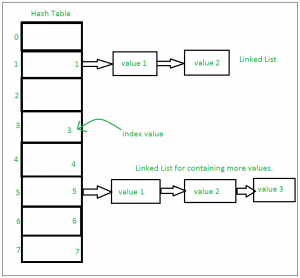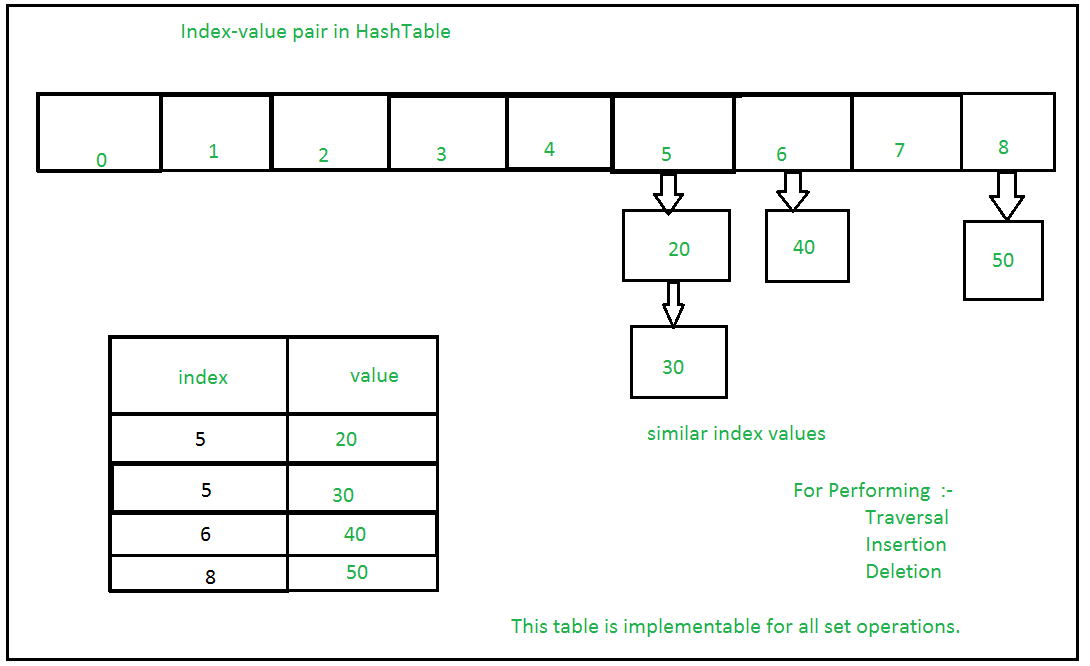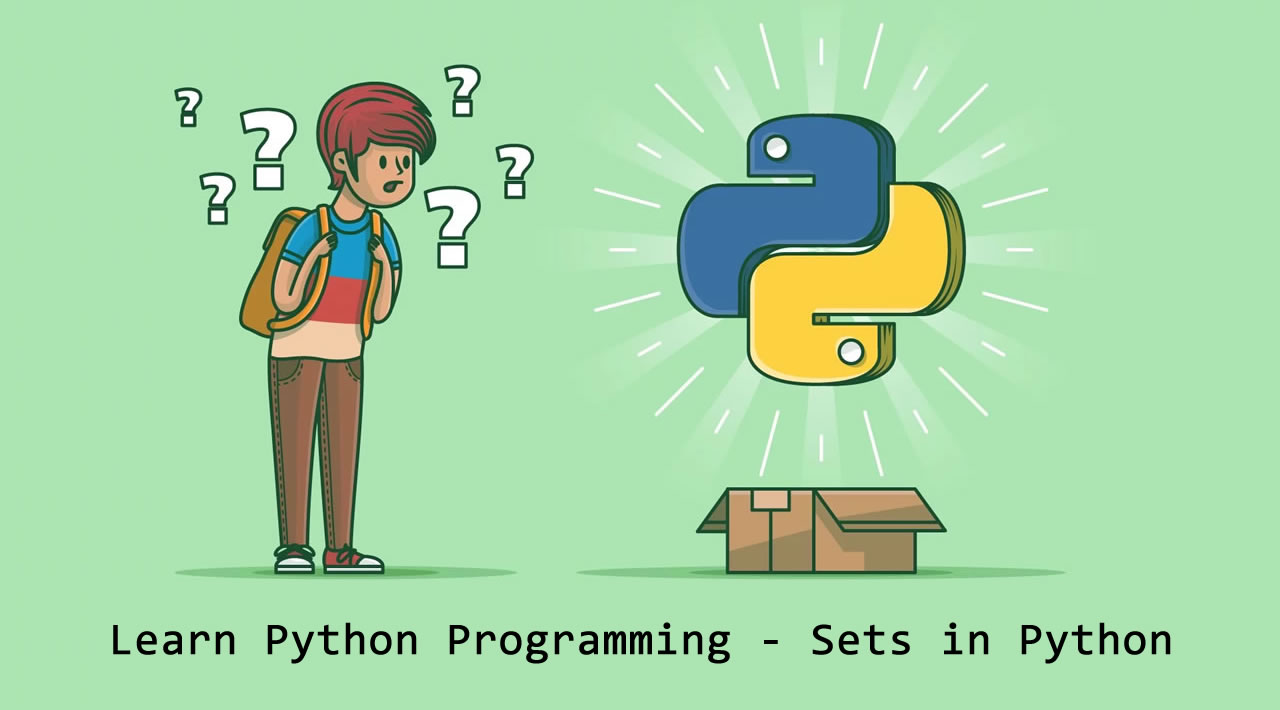Sets are a key way to store data in Python. In this tutorial, we show you how to create sets, how to add and remove elements from a set, and how to take the union and intersection of two sets. We will talk about lists, dictionaries and tuples in separate videos.
A Set is an unordered collection data type that is iterable, mutable and has no duplicate elements. Python’s set class represents the mathematical notion of a set. The major advantage of using a set, as opposed to a list, is that it has a highly optimized method for checking whether a specific element is contained in the set. This is based on a data structure known as a hash table. Since sets are unordered, we cannot access items using indexes like we do in lists.
# Python program to
# demonstrate sets
# Same as {"a", "b", "c"}
myset = set(["a", "b", "c"])
print(myset)
# Adding element to the set
myset.add("d")
print(myset)
Output:
{'c', 'b', 'a'}
{'d', 'c', 'b', 'a'}
Frozen Sets
Frozen sets in Python are immutable objects that only support methods and operators that produce a result without affecting the frozen set or sets to which they are applied. While elements of a set can be modified at any time, elements of the frozen set remain the same after creation.
If no parameters are passed, it returns an empty frozenset.
# Python program to demonstrate differences
# between normal and frozen set
# Same as {"a", "b","c"}
normal_set = set(["a", "b","c"])
print("Normal Set")
print(normal_set)
# A frozen set
frozen_set = frozenset(["e", "f", "g"])
print("\nFrozen Set")
print(frozen_set)
# Uncommenting below line would cause error as
# we are trying to add element to a frozen set
# frozen_set.add("h")
Output:
Normal Set
set(['a', 'c', 'b'])
Frozen Set
frozenset(['e', 'g', 'f'])
Internal working of Set
This is based on a data structure known as a hash table.
If Multiple values are present at the same index position, then the value is appended to that index position, to form a Linked List. In, Python Sets are implemented using dictionary with dummy variables, where key beings the members set with greater optimizations to the time complexity.
Set Implementation:-

Sets with Numerous operations on a single HashTable:-

Methods for Sets
Adding elements
Insertion in set is done through set.add() function, where an appropriate record value is created to store in the hash table. Same as checking for an item, i.e., O(1) on average. However, in worst case it can become O(n).
# A Python program to
# demonstrate adding elements
# in a set
# Creating a Set
people = {"Jay", "Idrish", "Archi"}
print("People:", end = " ")
print(people)
# This will add Daxit
# in the set
people.add("Daxit")
# Adding elements to the
# set using iterator
for i in range(1, 6):
people.add(i)
print("\nSet after adding element:", end = " ")
print(people)
Output:
People: {'Idrish', 'Archi', 'Jay'}
Set after adding element: {1, 2, 3, 4, 5, 'Idrish', 'Archi', 'Jay', 'Daxit'}
Union
Two sets can be merged using union() function or | operator. Both Hash Table values are accessed and traversed with merge operation perform on them to combine the elements, at the same time duplicates are removed. Time Complexity of this is O(len(s1) + len(s2)) where s1 and s2 are two sets whose union needs to be done.
# Python Program to
# demonstrate union of
# two sets
people = {"Jay", "Idrish", "Archil"}
vampires = {"Karan", "Arjun"}
dracula = {"Deepanshu", "Raju"}
# Union using union()
# function
population = people.union(vampires)
print("Union using union() function")
print(population)
# Union using "|"
# operator
population = people|dracula
print("\nUnion using '|' operator")
print(population)
Output:
Union using union() function
{'Karan', 'Idrish', 'Jay', 'Arjun', 'Archil'}
Union using '|' operator
{'Deepanshu', 'Idrish', 'Jay', 'Raju', 'Archil'}
Intersection
This can be done through intersection() or & operator. Common Elements are selected. They are similar to iteration over the Hash lists and combining the same values on both the Table. Time Complexity of this is O(min(len(s1), len(s2)) where s1 and s2 are two sets whose union needs to be done.
# Python program to
# demonstrate intersection
# of two sets
set1 = set()
set2 = set()
for i in range(5):
set1.add(i)
for i in range(3,9):
set2.add(i)
# Intersection using
# intersection() function
set3 = set1.intersection(set2)
print("Intersection using intersection() function")
print(set3)
# Intersection using
# "&" operator
set3 = set1 & set2
print("\nIntersection using '&' operator")
print(set3)
Output:
Intersection using intersection() function
{3, 4}
Intersection using '&' operator
{3, 4}
Difference
To find difference in between sets. Similar to find difference in linked list. This is done through difference() or – operator. Time complexity of finding difference s1 – s2 is O(len(s1))
# Python program to
# demonstrate difference
# of two sets
set1 = set()
set2 = set()
for i in range(5):
set1.add(i)
for i in range(3,9):
set2.add(i)
# Difference of two sets
# using difference() function
set3 = set1.difference(set2)
print(" Difference of two sets using difference() function")
print(set3)
# Difference of two sets
# using '-' operator
set3 = set1 - set2
print("\nDifference of two sets using '-' operator")
print(set3)
Output:
Difference of two sets using difference() function
{0, 1, 2}
Difference of two sets using '-' operator
{0, 1, 2}
Clearing sets
Clear() method empties the whole set.
# Python program to
# demonstrate clearing
# of set
set1 = {1,2,3,4,5,6}
print("Initial set")
print(set1)
# This method will remove
# all the elements of the set
set1.clear()
print("\nSet after using clear() function")
print(set1)
Output:
Initial set
{1, 2, 3, 4, 5, 6}
Set after using clear() function
set()
However, there are two major pitfalls in Python sets:
- The set doesn’t maintain elements in any particular order.
- Only instances of immutable types can be added to a Python set.
Time complexity of Sets

Operators for Sets
Sets and frozen sets support the following operators:

Code Snippet to illustrate all Set operations in Python
# Python program to demonstrate working# of
# Set in Python
# Creating two sets
set1 = set()
set2 = set()
# Adding elements to set1
for i in range(1, 6):
set1.add(i)
# Adding elements to set2
for i in range(3, 8):
set2.add(i)
print("Set1 = ", set1)
print("Set2 = ", set2)
print("\n")
# Union of set1 and set2
set3 = set1 | set2# set1.union(set2)
print("Union of Set1 & Set2: Set3 = ", set3)
# Intersection of set1 and set2
set4 = set1 & set2# set1.intersection(set2)
print("Intersection of Set1 & Set2: Set4 = ", set4)
print("\n")
# Checking relation between set3 and set4
if set3 > set4: # set3.issuperset(set4)
print("Set3 is superset of Set4")
elif set3 < set4: # set3.issubset(set4)
print("Set3 is subset of Set4")
else : # set3 == set4
print("Set3 is same as Set4")
# displaying relation between set4 and set3
if set4 < set3: # set4.issubset(set3)
print("Set4 is subset of Set3")
print("\n")
# difference between set3 and set4
set5 = set3 - set4
print("Elements in Set3 and not in Set4: Set5 = ", set5)
print("\n")
# checkv if set4 and set5 are disjoint sets
if set4.isdisjoint(set5):
print("Set4 and Set5 have nothing in common\n")
# Removing all the values of set5
set5.clear()
print("After applying clear on sets Set5: ")
print("Set5 = ", set5)
Output:
('Set1 = ', set([1, 2, 3, 4, 5]))
('Set2 = ', set([3, 4, 5, 6, 7]))
('Union of Set1 & Set2: Set3 = ', set([1, 2, 3, 4, 5, 6, 7]))
('Intersection of Set1 & Set2: Set4 = ', set([3, 4, 5]))
Set3 is superset of Set4
Set4 is subset of Set3
('Elements in Set3 and not in Set4: Set5 = ', set([1, 2, 6, 7]))
Set4 and Set5 have nothing in common
After applying clear on sets Set5:
('Set5 = ', set([]))
#python #web-development #machine-learning
